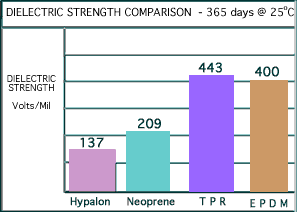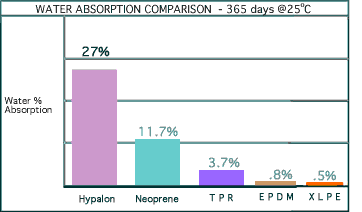|
| Technical Comparison Between TPR (1400 compound) and Neoprene/Polychloroprene (PCP)
The Table and graphs below compare some of the properties of the Amerace 1400 compound with those of PCPs. The TPR show its advantages particularly in the higher dielectric strength in water, and much lower water absorption. These are of particular benefit in airfield lighting applications where operation in water is common, and will promote higher circuit megger readings.
|
|
|
|
 |
|
 |
| . |
|
. |
|
|
| Characteristics |
FAA
Requirement |
PCP |
Amerace
1400
Compound |
| Tensile Strength - psi |
1200 |
1240 |
1230 |
| Tensile Strength * |
1000 |
1010 |
1080 |
| Tensile Strength ** |
1000 |
1070 |
1248 |
| Durometer Hardness - Per ASTM D2240 |
65 ± 10 |
55 |
73 |
| Other Characteristics |
| Compression Set - ASTM D-395 22 hrs. at 100°C |
76% |
33% |
| Dielectric Strength @ .06" thick (dry) volts/mil |
352 |
710 |
|
7 day soak @ R.T. |
|
362 |
693 |
|
7 day soak @90°C |
|
143 |
378 |
| Water Absorption (% Vol. Change) |
|
7 days at R.T |
|
1,0% |
0,7% |
|
14 days at R.T. |
|
1,4% |
0,9% |
|
3 days at 90°C |
|
12,4% |
3,1% |
|
7 days at 90°C |
|
20,2% |
4,4% |
|
14 days at 90°C |
|
28,1% |
6,2% |
Oil/Kerosene soak
(Mixture of SAE 30 motor oil and kerosene in 50/50 ratio) |
|
Hardness after 48 hours |
|
45 |
70 |
|
Hardness after 72 hours |
|
39 |
63 |
| Material Degradation |
None |
None |
| Acid/Alkaline soils (PH levels 4-9) |
No effect |
No effect |
| . |
| * After 96 hours oxygen bomb test - psi |
| ** After 168 hours in an oven test at 157°F - psi |
| . |
|
|
|